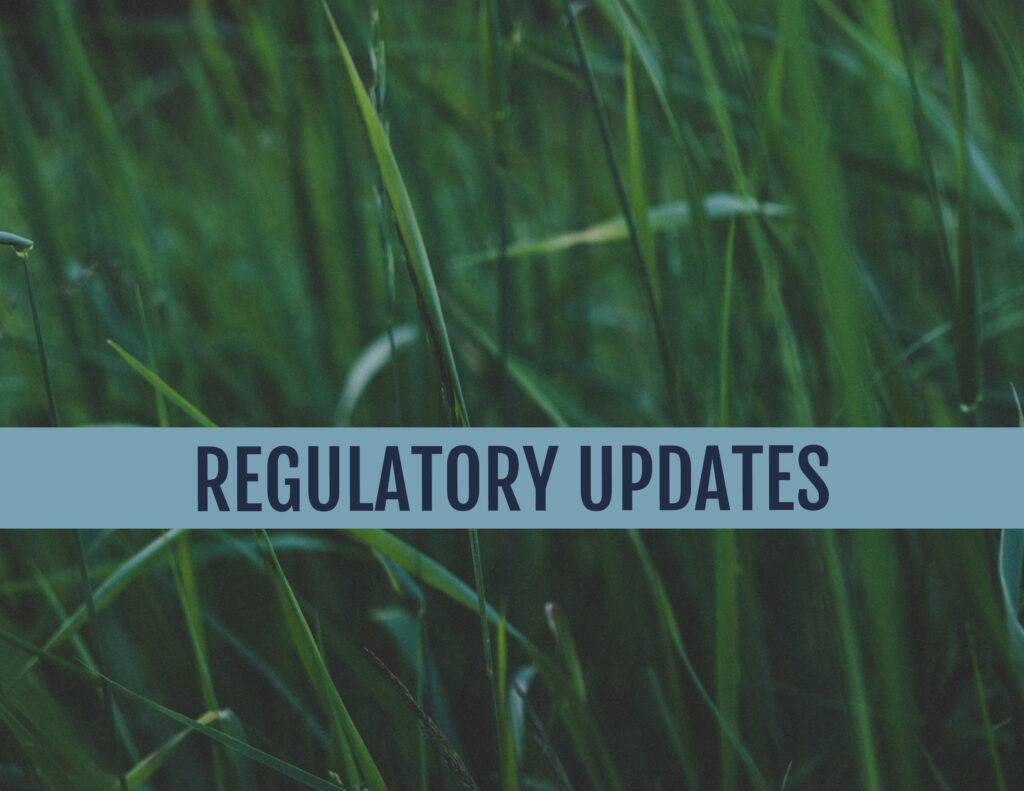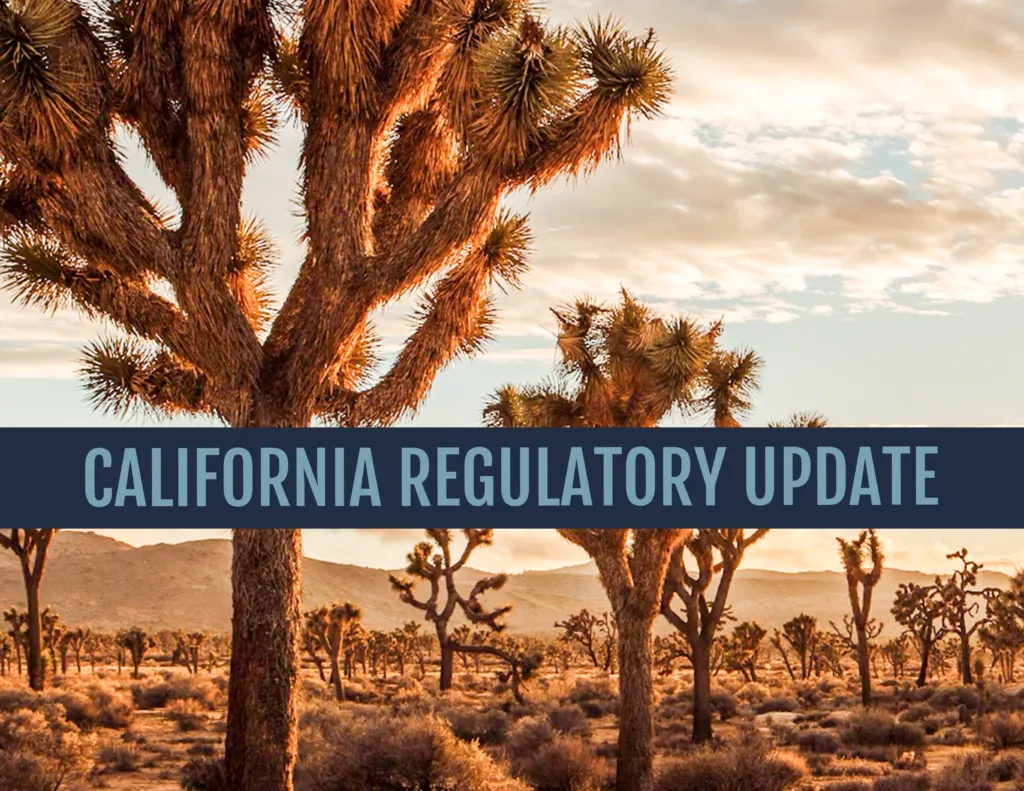
During the fourth quarter of 2023, there were several regulatory developments involving federal and state agencies. These updates are summarized in the following sections.
FEDERAL REGULATORY UPDATES
Environmental Protection Agency: Clean Water Act Section 401 Water Quality Certification Improvement Rule
On September 27, 2023, the United States (U.S.) Environmental Protection Agency (EPA) published a final rule to revise and replace the 2020 rule regarding regulatory requirements for the water quality certification process under Section 401 of the Clean Water Act (CWA). The final rule became effective on November 27, 2023. The proposed rule published on June 9, 2022 was previously discussed in our 2022 Q2 Regulatory Update.
The final rule restores certifying the ability of authorities (i.e., states, territories, and authorized tribes) to evaluate whether the “activity as a whole will comply with all applicable water quality requirements,” rather than merely the discharge. In addition, the rule limits the authority of federal agencies to review state or tribal decisions to the following:
- whether the appropriate certifying authority issued the certification decision,
- whether the certifying authority confirmed it complied with relevant public notice procedures, and
- whether the certifying authority acted on the request for certification within the “reasonable period of time.”
Procedural changes include:
- Allowing the certifying authority to waive or shorten the requirement to request a pre-filing meeting at least 30 days prior to submitting a certification request.
- Setting the default “reasonable period of time” to act on a request for certification as 6 months from the time a certifying authority receives the request. However, it should be noted that federal agencies and certifying authorities can agree to extend that period of time to the statutory maximum of 1 year.
- Establishing that the start of the “reasonable period of time” requirement is when the certifying authority receives a request for certification.
On December 4, 2023, the final rule was challenged by a coalition of states (Louisiana, Alaska, Arkansas, Kentucky, Mississippi, Missouri, Montana, Oklahoma, South Carolina, West Virginia, and Wyoming) and regulated entities that assert the final rule goes beyond the authority afforded to the EPA under the CWA; those plaintiffs cite Louisiana v. EPA, which was filed in the U.S. District Court for the Western District of Louisiana. A preliminary injunction has been filed to freeze the final rule while the lawsuit proceeds. If the court grants this injunction, the final rule will go into effect in the states where the rule has not been challenged and the 2020 Rule would apply in the states bringing the lawsuit until the litigation concludes.
United States Fish and Wildlife Service: Threatened Status With Section 4(D) Rule for the Western Spadefoot
On December 5, 2023, the U.S. Fish and Wildlife Service (USFWS) published a proposed rule to list two distinct population segments (DPSs) of the western spadefoot (Spea hammondii) as threatened under the Endangered Species Act (ESA). The northern DPS is found from Shasta County through the Central Valley, and from Santa Clara County to Santa Barbara County. The southern DPS is found from Los Angeles County to northwestern Baja California in Mexico. The Transverse Ranges separate the northern DPS from the southern DPS. Threats to western spadefoot include habitat loss and fragmentation; predation by nonnative species, such as bullfrogs; and the effects of climate change, such as droughts and increasing temperatures.
The USFWS is also proposing a 4(d) rule that provides exceptions for activities that will not result in a take under the ESA for the following activities:
- specific types of fuels management (i.e., to reduce the risk of large-scale high-severity wildfire or to establish and maintain required minimum defensible space from homes or structures);
- routine livestock ranching activities on private lands; and
- certain livestock grazing actions used as a habitat management tool.
Public comments on the proposed listing are due by February 5, 2024.
United States Department of Energy: National Hydrogen Hubs
On October 13, 2023, the U.S. Department of Energy (DOE) announced the selection of seven Regional Clean Hydrogen Hubs (H2Hubs) that will be provided with up to $7 billion in funding to jump-start a national network of clean hydrogen infrastructure and producers. The selected projects include:
- Appalachian Hydrogen Hub (Appalachian Regional Clean Hydrogen Hub [ARCH2]) in West Virginia, Ohio, and Pennsylvania;
- California Hydrogen Hub (Alliance for Renewable Clean Hydrogen Energy Systems [ARCHES]) in California;
- Gulf Coast Hydrogen Hub (HyVelocity H2Hub) in Texas;
- Heartland Hydrogen Hub in Minnesota, North Dakota, and South Dakota;
- Mid-Atlantic Hydrogen Hub (Mid-Atlantic Clean Hydrogen Hub [MACH2]) in Pennsylvania, Delaware, and New Jersey;
- Midwest Hydrogen Hub (Midwest Alliance for Clean Hydrogen [MachH2]) in Illinois, Indiana, and Michigan; and
- Pacific Northwest Hydrogen Hub (PNW H2) in Washington, Oregon, and Montana.
As part of the application process, each H2Hub was required to develop a comprehensive Community Benefits Plan that includes plans for engagement with communities; investment in the nation’s workforce; advancement of diversity, equity, inclusion, and accessibility; and maximization of benefits and minimization of harm to disadvantaged communities.
The selected projects are in award negotiations with the DOE’s Office of Clean Energy Demonstrations, which manages the H2Hubs program and will provide project management oversight. Once the projects receive an award, they will begin detailed project planning and compliance with the National Environmental Policy Act.
STATE REGULATORY UPDATES
State Water Resources Control Board: Waters of the U.S. Guidance
In response to the U.S. Supreme Court’s ruling in Sackett v. EPA and subsequent regulatory updates to the definition of “waters of the U.S.” (see our 2023 Q3 Regulatory Update), the State Water Resources Control Board (State Water Board) published a compilation of frequently asked questions to assist with understanding how the ruling affects waters within California. Highlights include:
- confirmation that the ruling does not affect the definition of “waters of the state” and that the Porter-Cologne Water Quality Control Act still protects waters that have lost their federal protection,
- an expectation of greater reliance on state permits for “waste discharge requirements” (WDRs),
- the anticipation of higher state workload and increased state fees to account for increased staffing resources and training needed to issue WDRs and conduct delineation verifications,
- consideration of adopting state delineation procedures for non-wetlands,
- confirmation that the CWA Section 401 water quality certifications issued prior to the ruling will not be revised,
- expectations that CWA Section 402 National Pollutant Discharge Elimination System (NPDES) permitting for discharges of pollutants to non-perennial tributaries of jurisdictional waters will be an area of high uncertainty for several years, and
- consideration for adopting replacement WDRs where NPDES permits are no longer required.
Governor’s Office of Planning And Research: Senate Bill 69
On October 13, 2023, Governor Gavin Newsom signed into law Senate Bill 69, which revises Public Resources Code Section 21152 to require notices of determination (NODs) and notices of exemptions (NOEs) to be filed with both the county clerk and the State Clearinghouse in the Governor’s Office of Planning and Research. Previously, when a local agency approved or agreed to carry out a project subject to the California Environmental Quality Act, the local agency was only required to file NODs and NOEs with the county clerk of each county in which the project was anticipated to be located. This change went into effect on January 1, 2024.


